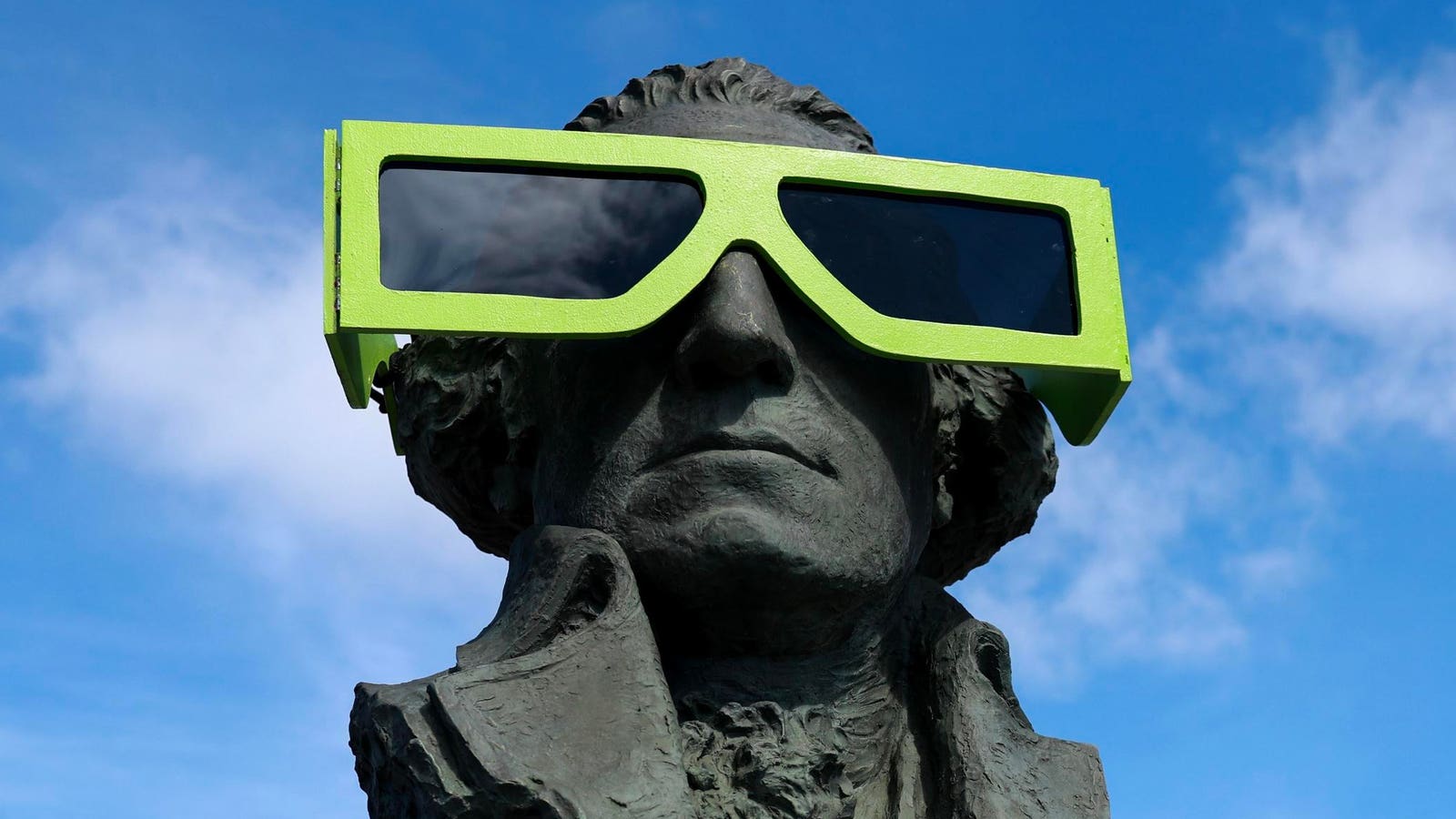Eclipse glasses are held by a statue of George Washington on April 7, 2024, in Houlton, Maine. … [+]
If the April 8 total solar eclipse across North America did anything, it put a pair of solar filters — in the form of eclipse glasses — into millions of households. It’s time to find them because there’s something to see in the sun this week that could soon produce some impressive northern and southern lights.
The reason is an increase in solar activity that is leaving visible marks on the sun, with black sunspots seen on the southeastern limb. If you have eclipse glasses, you can go outside right away and see them. Counting sunspots—dark, planet-sized regions of strong magnetic fields on the sun’s surface—is how scientists calculate how magnetically active the sun currently is. Sunspots are at a 23-year high.
Note: it is dangerous to look at the sun through anything other than a pair of certified safe solar filters (solar eclipse glasses) that meet the international safety standard ISO 12312-2. Don’t DIY, don’t wear sunglasses, and don’t use welding glasses (sometimes the latter if it’s safe, but only if it’s grade 13 or 14, which is hard to check). The American Astronomical Society maintains a list of Suppliers of safe solar filters and visors.
NASA SOHO images of the sun on October 16, 2024, showing multiple active sunspot regions in … [+]
Solar activity is increasing
The Sun produced an X9 solar flare – a sudden and intense burst of radiation – on October 3, the largest of Solar Cycle 25 so far. Then, in the wake of the resulting aurora around the world on October 10-11, the sun rested for a while. This ended in dramatic fashion when an X3.3-class solar flare was photographed by NASA’s SOHO spacecraft on Thursday, October 24, quickly followed by a smaller M1.2-class solar flare and, on Friday , on October 25 from a solar M1.1 class flare. Saturday, October 26 then saw M9.5 and X1.8 solar flares within an hour of each other. This is very rare. An M1.6 burst followed soon after.
These recent solar flares come mainly from AR3873, AR3872, and AR3869, active regions very close to the sun that are part of a large sunspot group southeast of the sun. Most importantly, these active regions are on the Earth’s side, so any coronal mass ejections—clouds of charged particles ejected from the sun—they produce could be directed toward Earth. Since CMEs take several days to reach Earth from the sun, this could be a dramatic aurora display next week.
NASA SOHO images of the sun on October 16, 2024, showing multiple active sunspot regions in … [+]
How to use solar eclipse glasses
The sun only takes up half a degree of the sky, so trying to find it while wearing solar eclipse glasses isn’t easy. A good way to use solar eclipse glasses is to:
- Stand and face the sun with your eyes on the ground.
- Lift the solar eclipse glasses to your face and secure them in place.
- Lift your neck to look at the sun directly in front of or above you.
Maximum solar news
In the wake of the October 10-11 aurora, an announcement was made by NASA and the National Oceanic and Atmospheric Administration’s (NOAA) Solar Cycle 25 Prediction Panel that the sun had reached its “solar maximum” phase. This peak of the sun’s 11-year solar cycle, during which its magnetic activity waxes and wanes, may last for the next year or more.
This means a high chance of more Northern Lights. As a bonus, the solar maximum is likely to last longer than usual, scientists think, and is likely to produce frequent and powerful geomagnetic storms through 2026.
Images from NASA’s Solar Dynamics Observatory highlight the appearance of the Sun at solar minimum … [+]
What do solar eclipse glasses do?
Solar eclipse glasses protect your eyes by blocking visible short-wavelength bluish light that can damage your retina. As a result of our development under the sun, the solar spectrum peaks at the point where human eyes are most sensitive, with this short-wavelength sunlight causing a photochemical reaction.
Solar eclipse glasses are made by passing molten aluminum through polyester film to create an aluminum-coated polyester filter. Other types of solar filters are made of dark polymer resin saturated with carbon black.
I wish you clear skies and open eyes.
